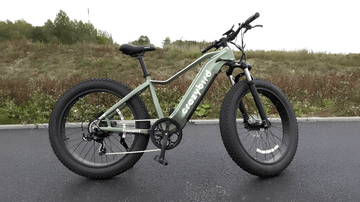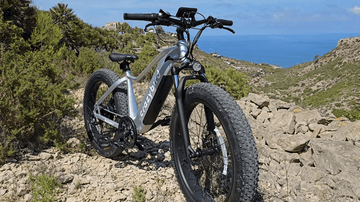
Curious about the mechanics behind electric bikes? In this comprehensive guide, we delve into the inner workings of electric bikes, explaining the key components like the battery, motor, and controller. Discover the fascinating technology that powers electric bikes, learn about their benefits, and gain a deeper understanding of their operation. Read on to unravel the secrets behind the seamless integration of these components in electric bikes.
Introduction:
Electric bikes have transformed the way we commute and explore, offering an efficient, eco-friendly, and enjoyable alternative to traditional bicycles. But have you ever wondered how these remarkable machines actually work? In this comprehensive guide, we will take an in-depth look at the mechanics behind electric bikes, uncovering the technology that propels these innovative vehicles.
At the heart of every electric bike are three essential components: the battery, motor, and controller. These components work in harmony to provide electric assistance, transforming your cycling experience. Join us as we explore each component, examining their functions, interactions, and contributions to the overall operation of electric bikes.
Section 1: Empowering the Ride - The Battery:
The battery is the powerhouse of an electric bike, providing the energy required for propulsion. In this section, we will delve into the intricacies of electric bike batteries, including their types, capacity, and charging considerations.
We will explore the most commonly used battery types in electric bikes, such as lithium-ion (Li-ion) and lithium polymer (LiPo) batteries, discussing their advantages in terms of energy density, weight, and longevity. We will also examine battery capacity and its impact on range and performance, as well as factors to consider when choosing a battery for your electric bike.
Moreover, we will explore charging methods, covering aspects like standard charging, fast charging, and charging infrastructure. We will provide insights on how to maximize battery life and efficiency, including optimal charging practices and storage recommendations.
To address common battery-related concerns, we will tackle topics such as battery lifespan, recycling, and environmental impact. By the end of this section, you will have a comprehensive understanding of the critical role batteries play in powering your electric bike.
Section 2: Power in Motion - The Motor:
The motor is the heart of an electric bike, converting electrical energy from the battery into mechanical power. In this section, we will explore the intricacies of electric bike motors, including their types, power ratings, and performance characteristics.
We will delve into the two primary motor types found in electric bikes: hub motors and mid-drive motors. We will discuss their respective advantages, disadvantages, and applications, considering factors like efficiency, torque, and responsiveness. Additionally, we will explore motor power ratings, including wattage and torque, and how they influence speed, acceleration, and overall performance.
Furthermore, we will cover motor control systems, such as pedal-assist sensors and throttle mechanisms, examining how they regulate the motor's output and provide varying levels of electric assistance. We will also touch upon regenerative braking systems, which harness kinetic energy during braking to recharge the battery.
To provide practical insights, we will review popular electric bike motor brands and models, discussing their features, performance, and customer feedback. By the end of this section, you will have a comprehensive understanding of how the motor converts electrical energy into mechanical power, propelling your electric bike forward.
Section 3: The Brain Behind the Ride - The Controller:
The controller acts as the central control unit, coordinating the interactions between the battery, motor, and other electrical components. In this section, we will delve into the functionalities of the controller, its role in managing electric bike operations, and its impact on ride quality.
We will explore how the controller regulates power output from the battery to the motor, controlling parameters like speed, acceleration, and electric assistance levels. We will discuss the significance of the controller's software and firmware, which determine the behavior and performance characteristics of the electric bike.
Moreover, we will examine the controller's role in monitoring and protecting the battery, ensuring optimal charging and discharging cycles while preventing overcharging or overheating. We will touch on safety features integrated into controllers, such as temperature sensors and current limiters.
To provide practical insights, we will discuss the user interface of controllers, including display panels, control buttons, and connectivity options. We will highlight advanced controller features like programmable settings, real-time data feedback, and integration with mobile applications.
By the end of this section, you will gain a comprehensive understanding of how the controller serves as the brain of an electric bike, orchestrating the efficient functioning of key components.
Section 4: Unveiling the Benefits of Electric Bikes:
In this section, we will explore the numerous benefits that electric bikes offer, which have contributed to their widespread popularity and adoption.
-
Commuting Efficiency: Electric bikes provide a faster and more efficient mode of transportation, allowing riders to cover longer distances with less effort. They offer a viable alternative to cars, reducing traffic congestion and commuting time.
-
Health and Fitness: Contrary to popular belief, electric bikes still require pedaling, but with added assistance. This promotes physical activity, improves cardiovascular health, and encourages individuals to lead an active lifestyle.
-
Environmental Friendliness: Electric bikes produce zero emissions during operation, making them an environmentally friendly transportation option. By choosing electric bikes over cars or motorcycles, riders contribute to reducing air pollution and carbon footprint.
-
Cost Savings: Electric bikes offer cost savings compared to traditional vehicles. They require minimal maintenance, and the cost of charging the battery is significantly lower than fueling a car or motorcycle. Additionally, e-bikes can replace or reduce the need for public transportation expenses.
-
Accessibility: Electric bikes make cycling accessible to a broader range of individuals. They allow people with varying fitness levels or physical limitations to enjoy the benefits of cycling, enabling more people to participate in active transportation.
-
Hill Climbing and Range Extension: Electric bikes assist riders when tackling hills and challenging terrains, making cycling more accessible in hilly regions. The electric assistance also extends the range riders can cover, encouraging exploration and longer rides.
-
Versatility: Electric bikes are versatile, catering to a wide range of riding preferences and needs. They can be used for daily commuting, recreational rides, urban exploration, and even off-road adventures, offering a multi-purpose transportation solution.
Conclusion:
Congratulations! You now have a comprehensive understanding of how electric bikes work, from the battery's role in powering the ride to the motor's conversion of electrical energy into mechanical power, and the controller's management of the entire process. Additionally, you have explored the numerous benefits that electric bikes bring to riders and the environment.
By comprehending the inner workings of electric bikes, you are empowered to make informed decisions when selecting an electric bike, upgrading components, or maintaining your existing electric bike.
Embrace the convenience, efficiency, and excitement of electric biking, and enjoy the benefits of this sustainable and innovative mode of transportation. With every pedal stroke, you contribute to a greener future while experiencing the joy of effortless exploration. Happy riding!













